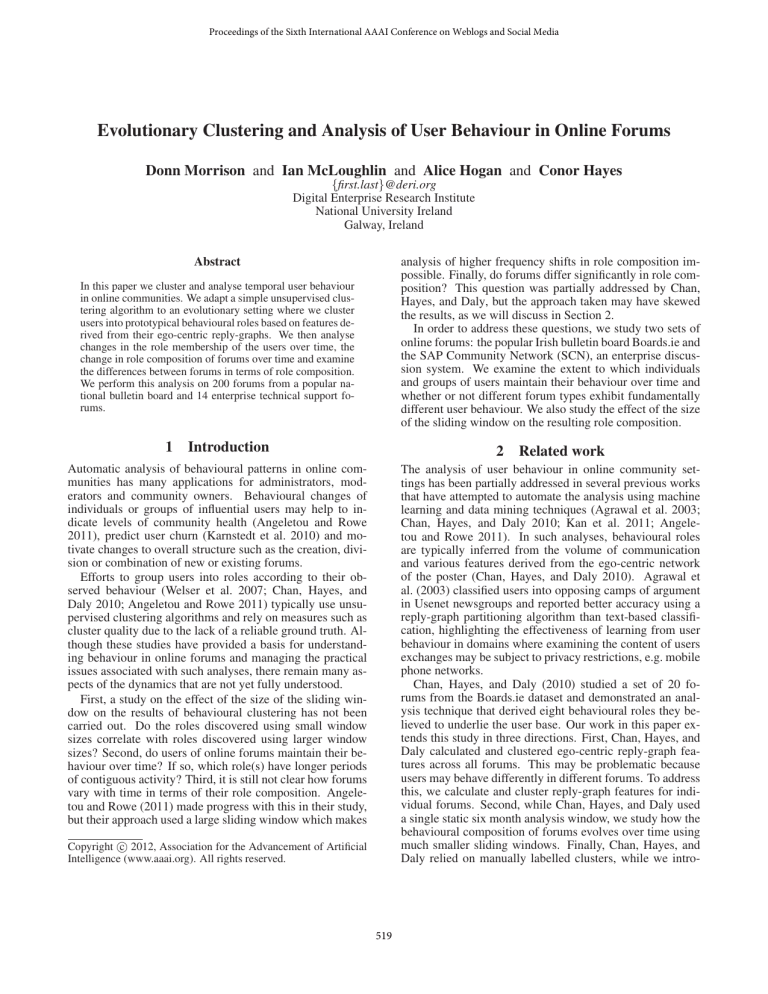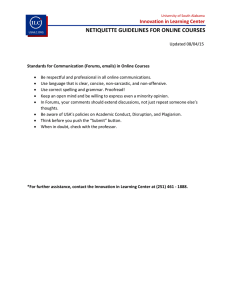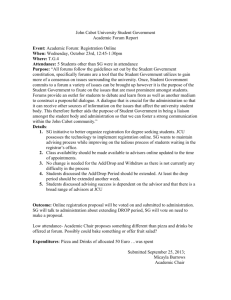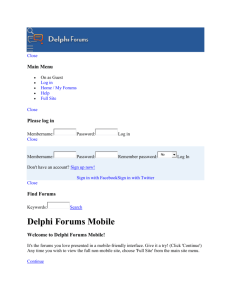
Proceedings of the Sixth International AAAI Conference on Weblogs and Social Media
Evolutionary Clustering and Analysis of User Behaviour in Online Forums
Donn Morrison and Ian McLoughlin and Alice Hogan and Conor Hayes
{first.last}@deri.org
Digital Enterprise Research Institute
National University Ireland
Galway, Ireland
Abstract
analysis of higher frequency shifts in role composition impossible. Finally, do forums differ significantly in role composition? This question was partially addressed by Chan,
Hayes, and Daly, but the approach taken may have skewed
the results, as we will discuss in Section 2.
In order to address these questions, we study two sets of
online forums: the popular Irish bulletin board Boards.ie and
the SAP Community Network (SCN), an enterprise discussion system. We examine the extent to which individuals
and groups of users maintain their behaviour over time and
whether or not different forum types exhibit fundamentally
different user behaviour. We also study the effect of the size
of the sliding window on the resulting role composition.
In this paper we cluster and analyse temporal user behaviour
in online communities. We adapt a simple unsupervised clustering algorithm to an evolutionary setting where we cluster
users into prototypical behavioural roles based on features derived from their ego-centric reply-graphs. We then analyse
changes in the role membership of the users over time, the
change in role composition of forums over time and examine
the differences between forums in terms of role composition.
We perform this analysis on 200 forums from a popular national bulletin board and 14 enterprise technical support forums.
1
Introduction
2
Automatic analysis of behavioural patterns in online communities has many applications for administrators, moderators and community owners. Behavioural changes of
individuals or groups of influential users may help to indicate levels of community health (Angeletou and Rowe
2011), predict user churn (Karnstedt et al. 2010) and motivate changes to overall structure such as the creation, division or combination of new or existing forums.
Efforts to group users into roles according to their observed behaviour (Welser et al. 2007; Chan, Hayes, and
Daly 2010; Angeletou and Rowe 2011) typically use unsupervised clustering algorithms and rely on measures such as
cluster quality due to the lack of a reliable ground truth. Although these studies have provided a basis for understanding behaviour in online forums and managing the practical
issues associated with such analyses, there remain many aspects of the dynamics that are not yet fully understood.
First, a study on the effect of the size of the sliding window on the results of behavioural clustering has not been
carried out. Do the roles discovered using small window
sizes correlate with roles discovered using larger window
sizes? Second, do users of online forums maintain their behaviour over time? If so, which role(s) have longer periods
of contiguous activity? Third, it is still not clear how forums
vary with time in terms of their role composition. Angeletou and Rowe (2011) made progress with this in their study,
but their approach used a large sliding window which makes
Related work
The analysis of user behaviour in online community settings has been partially addressed in several previous works
that have attempted to automate the analysis using machine
learning and data mining techniques (Agrawal et al. 2003;
Chan, Hayes, and Daly 2010; Kan et al. 2011; Angeletou and Rowe 2011). In such analyses, behavioural roles
are typically inferred from the volume of communication
and various features derived from the ego-centric network
of the poster (Chan, Hayes, and Daly 2010). Agrawal et
al. (2003) classified users into opposing camps of argument
in Usenet newsgroups and reported better accuracy using a
reply-graph partitioning algorithm than text-based classification, highlighting the effectiveness of learning from user
behaviour in domains where examining the content of users
exchanges may be subject to privacy restrictions, e.g. mobile
phone networks.
Chan, Hayes, and Daly (2010) studied a set of 20 forums from the Boards.ie dataset and demonstrated an analysis technique that derived eight behavioural roles they believed to underlie the user base. Our work in this paper extends this study in three directions. First, Chan, Hayes, and
Daly calculated and clustered ego-centric reply-graph features across all forums. This may be problematic because
users may behave differently in different forums. To address
this, we calculate and cluster reply-graph features for individual forums. Second, while Chan, Hayes, and Daly used
a single static six month analysis window, we study how the
behavioural composition of forums evolves over time using
much smaller sliding windows. Finally, Chan, Hayes, and
Daly relied on manually labelled clusters, while we intro-
Copyright c 2012, Association for the Advancement of Artificial
Intelligence (www.aaai.org). All rights reserved.
519
centroids k. At each time step t, K-means finds a partition
{V1,t , ..., Vk,t } that minimises:
k X
X
KM =
||~vi,t − µ
~ l,t ||2 ,
(1)
duce a rule-based approach that effectively maps clusters to
behavioural roles.
Similarly, Angeletou and Rowe (2011) clustered users of
three forums from the Boards.ie dataset into behavioural
roles as a precursor to predicting community health. Using
a 13 week sliding window, they used the same reply-graph
features and role definitions as Chan, Hayes, and Daly.
However, the authors used equal frequency unsupervised
binning, a method that maps numerical variables to categorical labels, to perform the clustering and role labelling, which
resulted in a high number of unclassified users that could not
be analysed. Our method of evolutionary clustering assigns
a prototypical role to all users.
Kan et al. (2011) examined normative user behaviour via
a temporal post-reply ratio in Boards.ie and concluded that
users tend to have consistent conversational behaviour over
time. The difference between our work is that we consider
a wider array of features and represent users as members of
prototypical behavioural roles.
3
3.1
l=1 i∈Vl,t
where ~vi,t ∈ Rm is the feature vector and µ
~ l,t denotes the
centroid for cluster l. We extend K-means to evolutionary
clustering by mapping centroid µ
~ l,t → µ
~ l,t+1 such that Kmeans is initialised from where the update method for the
previous time step converged (Chi et al. 2009). We demonstrate in Section 4 that this approach is a simple and effective
way to perform evolutionary clustering.
3.3
Methodology
Datasets and features
We analyse two datasets in this study. The first is the popular Irish bulletin board Boards.ie, comprising over 700 individual forums covering a wide variety of topics, 200 of
which had sufficient activity (at least 10 active users per time
window) for analysis. The second dataset is the SAP Community Network (SCN), an enterprise discussion system focussed on technical support of products developed by SAP,
with 14 of the 33 forums having sufficient activity for analysis (as above). The analysis period for Boards.ie was the
full year 2006 and for SAP was the full year 2008. The list
of analysed forums is omitted due to space limitations, but
selected forums are presented in Section 4 to illustrate the
effectiveness of our approach.
The features used in this study are based on the egocentric reply-graphs of the users in each forum (Chan,
Hayes, and Daly 2010; Rowe and Angeletou 2011). In
(Chan, Hayes, and Daly 2010) fifty features were analysed
and of those nine were retained following a feature correlation analysis. In this study, we make use of these nine
features: in-degree (ind), exponentiated in-degree (inex), exponentiated out-degree (outex), percentage of posts receiving replies (ppr), number of bi-directional neighbours (bin),
number of threads with bi-directional neighbours (thbi),
threads initiated (th), mean posts per thread (mpth), standard deviation of posts per thread (spth). We also consider
an additional feature, forum entropy (ent) (Rowe and Angeletou 2011). The reader is referred to (Chan, Hayes, and
Daly 2010; Rowe and Angeletou 2011) for full details of
these features. All features are calculated based on the replygraph constructed for a given time window, i.e. events that
occurred outside of the window are not considered. We report on the effect of the window size in Section 4.
3.2
User roles
The behavioural roles we defined for this study are based
on those introduced by Chan, Hayes, and Daly (2010). As
most forums showed a preference for four clusters,1 we set
the number of roles to be four and defined a set of decision
rules to create a mapping between the clusters and roles. For
consistency, we retain the primary descriptors from Chan,
Hayes, and Daly and show the correspondence to the original roles in Table 1.
The decision rule listed as Algorithm 1 maps the clusters
to roles using the feature means of the member elements.
Prior to the mapping, the feature means are scaled into the
range [0, 1].
Algorithm 1 Role labelling decision rule set.
Input: Set of K clusters C with cendroid means {ppr, inex, outex}
Output: Set of K labels L
supporter ← c ∈ C : argmaxc pprc + inexc + outexc
C ← C\c
ignored ← c ∈ C : argmaxc (1-inexc ) + outexc
C ← C\c
grunt ← c ∈ C : argmaxc (1-outexc ) + (1-|inexc -outexc |)
C ← C\c
elitist ← c ∈ C
L ← {supporter,ignored,grunt,elitist}
3.4
Experimental setup
The analysis carried out in this study was conducted as follows. First, the reply-graph features were extracted from
the forum data using the pre-selected window sizes (seven,
15 and 30 days). Next, for each forum, the features were
clustered using the evolutionary extension to K-means introduced in Section 3.2 using k = 4 cluster centroids.
Finally, at each time step, the behavioural roles defined
in Table 1 are mapped to the clusters based on the values
of each clusters’ feature means (see Algorithm 1). Figure
1 shows the After Hours forum from the Boards.ie dataset
decomposed into the roles over the three window sizes. The
role heatmap (left) shows user membership in each role (denoted by colour) at each time step. The smoothing effect as
the window size increases is apparent.
4
Evolutionary clustering with K-means
Results and discussion
First, we examine the effect of window size on the role composition of each forum. For each window size (seven, 15, 30
K-means is a popular unsupervised clustering algorithm that
converges on a local minimum by a two-step iterative process. The only parameter it requires is the number of initial
1
520
Empirically determined via model selection over all forums.
Table 1: Role definitions, characteristics and correspondence to the roles defined by Chan, Hayes, and Daly (2010).
Role label
Features
Chan’s roles
Supporter
High % posts receiving replies, high exponentiated indegree
Low exponentiated in-degree, high exponentiated outdegree
Medium-high stdev posts-per-thread, low exponentiated out-degree
Medium-high mean posts-per-thread, medium-high
exponentiated out-degree
Supporter/popular
pant/popular initiator
Ignored/taciturn
Ignored
Grunt
Elitist
Characteristics
partici-
Grunt/joining conversationalist
Stable backbone of the forum; contributes useful content that yields replies
Generally ignored by other users; in unmoderated forums spammers would fall into this role
Communication with few users
Elitist
High communication with few users
Table 2: Pearson correlation between window sizes by role
(* p < 0.05).
Window sizes
7 and 15 day
7 and 30 day
15 and 30 day
(a) Boards.ie
Supporter Ignored
0.24*
0.25*
0.18
0.18
0.32*
0.28*
Grunt
0.34*
-0.02
0.25*
Elitist
0.05
-0.08
0.00
Window sizes
7 and 15 day
7 and 30 day
15 and 30 day
(b) SAP
Supporter Ignored
0.86*
-0.68
0.80*
-0.04
0.79*
0.31
Grunt
0.55
0.62
0.24
Elitist
-0.20
0.11
0.80*
(a) 7 day window
(b) 15 day window
(a) Boards.ie After Hours
(b) Boards.ie Moderators
(c) SAP BO SDK
(d) SAP BO Core
(c) 30 day window
Figure 1: Evolutionary clustering of the After Hours forum
from the Boards.ie dataset for three window sizes. Role
heatmap (left) and forum composition (right).
day), we calculated the average role composition of each forum and measured the Pearson correlation between each pair
of vectors and recorded the significance values. The results
are presented in Table 2 and show that the window size does
have an effect on the role composition. For the Boards.ie
dataset, the correlation between a seven and 30 day window
is lowest, with no significance found. Correlation between
seven and 15 day windows is higher, with Supporter, Ignored, and Grunt roles found to be significant (the Elitist
role has no significant correlation). The same is true for the
correlation between the 15 and 30 day window, which is the
most correlated. Again, the Elitist role has almost no correlation between window sizes, suggesting that the role is
highly unstable as the window size changes. For the SAP
dataset, the Supporters role was found to be highly correlated (> 0.79, p < 0.05) across all window sizes. The
Ignored role was correlated (but not significant) between
seven and 15 day windows and seven and 30 day windows,
but less correlated between 15 and 30 day windows. The
Elitist role was highly correlated (0.80, p < 0.05) between
15 and 30 day windows. Roles derived from independent
Figure 2: Role duration distributions for various forums.
clusterings on the same window size for both datasets, on
the other hand, are all highly correlated (> 0.8, p < 0.05).
We next examine whether and to what extent users maintain their roles over time. Figure 2 shows the log distributions of role durations for a subset of forums from the
Boards.id and SAP datasets. Each distribution corresponds
to a role and shows the log number of users that maintained
that role for n contiguous time steps, where n increases from
left to right by one time step (with each bin) to the last time
step (23 for the 15 day window size). For example, Figure 2 (a) shows that in the After Hours forum Grunts are
both the most common type of user and have the longest
contiguous role durations. The right-most bin stands out
for that role, showing that a considerable fraction (35 users)
maintain Grunt behaviour, uninterrupted, for the entire year.
These role duration distributions, combined with the role
heatmaps (such as in Figure 1), show that the majority of
users maintain their roles for more than one time step, and
many maintain their roles for much longer.
521
(a) Boards.ie Motors
(b) Boards.ie Bargain Alerts
(c) SAP BO SDK
(d) SAP BO Core
ysed over time. We found that certain roles were more stable between window sizes than others (Supporter, Ignored,
Grunt users for the Boards.ie dataset and Supporters for
the SAP dataset). Forums with higher activity (number of
users) generally had better stability between window sizes.
In some forums, considerable fractions of users maintain
their roles over long periods. It was also observed that in
some high activity forums, small groups of users, usually
Grunts, maintained their behaviour for the entire analysis
period. In other forums, such as Helpdesk or Soccer Access Requests, users rarely maintain their role for more than
one time step due to the nature of the activity in the forum.
Grunt users, defined as those users who communicate with
few other users, were seen to be the most dominant role
throughout most of the forums, especially in those that were
more active, a finding supported by (Chan, Hayes, and Daly
2010).
We found that only a handful of the analysed forums, particularly the high activity forums (e.g. Motors), showed stable role compositions over time. Other forums (e.g. SAP BO
Core) had compositions that changed slowly and steadily
over time. Further analysis is required with knowledge of
external events to determine why this may be the case. We
found that generally the most active forums have similar
compositions, however, some forums have very different
compositions to the others (e.g. Soccer versus Soccer Access Requests) and can be explained by their nature which
in turn governs the user behaviour.
Figure 3: Role composition change over time for various
forums.
(a) Soccer Access Requests
(b) Soccer
Figure 4: Cluster heatmaps and role compositions for two
related forums with very different role compositions.
The question of whether the role composition of a forum
changes over time can be illustrated by Figure 3. Each plot
shows the number of users in each role at each time step
(15 day window). Forums such as Motors show relatively
stable role compositions over time. There are no influxes of
certain roles and one can expect that these would remain stable beyond the analysis window. Forums with more actively
changing role compositions such as SAP BO SDK show that
users change between roles, typically Grunt and Elitist for
certain durations. This is confirmed by inspecting the corresponding role heatmap (not shown for these forums). Bargain Alerts also shows composition changes over time with
more Grunts towards the end of the analysis period (which,
incidentally, corresponds to the beginning of the Christmas
season).
Finally, we examine the question of whether different forums differ and to what extent in their role composition. This
question has already been partially answered above in the
analysis of role compositions over time. We further illustrate this with some examples. Figure 4 shows two forums
with a topic in common: football. The first forum, Soccer
Access Requests, exists so that users can request access to
the second forum, Soccer, because it is private. Users in
the first forum are almost exclusively active for the window
in which they issue the request, and once granted, have no
need to participate further. The Soccer Access Requests has
sparse activity and is composed of mainly Ignored users,
while the Soccer forum has a wide variety of role types and
a high level of activity.
5
Acknowledgements
This work was funded by the European Union (EU) and Science
Foundation Ireland (SFI) in the course of the projects ROBUST
(EU grant no. 257859) and CLIQUE Strategic Research Cluster (SFI grant no. 08/SRC/I1407), and LION-2 (SFI grant no.
SFI/08/CE/I1380).
References
Agrawal, R.; Rajagopalan, S.; Srikant, R.; and Xu, Y. 2003. Mining newsgroups using networks arising from social behavior. In
Proceedings of the 12th international conference on World Wide
Web, 529–535. ACM.
Angeletou, S., and Rowe, M. 2011. Modelling and analysis of user
behaviour in online communities.
Chan, J.; Hayes, C.; and Daly, E. M. 2010. Decomposing Discussion Forums and Boards Using User Roles. In International AAAI
Conference on Weblogs and Social Media, 215–218.
Chi, Y.; Song, X.; Zhou, D.; Hino, K.; and Tseng, B. L. 2009. On
evolutionary spectral clustering. ACM Transactions on Knowledge
Discovery from Data 3(4):1–30.
Kan, A.; Chan, J.; Hayes, C.; Hogan, B.; Bailey, J.; and Leckie,
C. 2011. A Time Decoupling Approach for Studying Forum Dynamics. World Wide Web Internet And Web Information Systems In
press:1–24.
Karnstedt, M.; Rowe, M.; Chan, J.; Alani, H.; and Hayes, C. 2010.
The Effect of User Features on Churn in Social Networks. Human
Factors.
Rowe, M., and Angeletou, S. 2011. Predicting discussions on the
social semantic web. Web: Research and Applications.
Welser, H.; Gleave, E.; Fisher, D.; and Smith, M. 2007. Visualizing
the signatures of social roles in online discussion groups. Journal
of Social Structure 8(2):564–586.
Conclusions
This study used evolutionary clustering to group users of
online forums into behavioural roles which were then anal-
522





